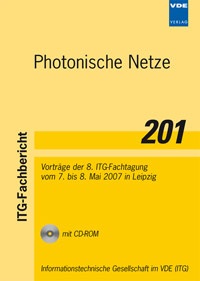Carrier Grade Metro Ethernet Networks
Conference: Photonische Netze - 8. ITG-Fachtagung
05/07/2007 - 05/08/2007 at Leipzig, Germany
Proceedings: Photonische Netze
Pages: 8Language: englishTyp: PDF
Personal VDE Members are entitled to a 10% discount on this title
Authors:
Autenrieth, Achim; Kirstädter, Andreas (Siemens Networks GmbH&Co)
Edmaier, Bernhard; Epple, Clemens (BT (Germany) GmbH&Co oHG)
Eilenberger, Gert; Grammel, Gert (Alcatel-Lucent Deutschland AG)
Gladisch, Andreas; Westphal, Fritz-Joachim (T-Systems)
Grobe, Klaus (ADVA AG Optical Networking)
Obermann, Kristof (FH Regensburg)
Patzak, Erwin; Schlosser, Michael (Fraunhofer-Institut für Nachrichtentechnik, Heinrich-Hertz-Institut)
Abstract:
This paper gives an overview on actual trends and deployments of carrier-grade Ethernet in metro, access, and core networks. This includes the related motivation, concepts, and technologies as well as open issues regarding research, development, and standardization. Ethernet as a packet-based, connection-oriented technology is deployed for metro networks worldwide today. This is driven by the massive increase of (IP-based) data traffic and the related applications. The Ethernet deployments aim at most cost-efficient data service provisioning and the migration of all legacy Layer-2 services towards a unified platform. The goal is a massive reduction of both, CapEx and OpEx. Network operators and service providers impose increased requirements regarding scalability, quality of service including reliability and availability, and Operations, Administration, and Maintenance (OAM) features on their metro Ethernet solutions. These requirements are usually referred to as carrier-grade or transport Ethernet. Metro Ethernet services as deployed today mainly consist of Ethernet Private Lines (EPL) or Ethernet Virtual Private LANs (EVPLAN). These can provide dedicated LAN extension or LAN-like connectivity via IP/MPLS, respectively. A different approach is Pseudowire Emulation Edge-to-Edge (PWE3) which allows MPLS transport of Ethernet and other packet services as well as synchronous TDM services. Various network architecture and protocol options exist to migrate from metro SONET/SDH and WDM networks towards even more Ethernet-centric and -optimized networks. These include Layer-2 transport like Transport MPLS (T-MPLS), Provider Backbone Transport (PBT), and Ethernet-over-SONET/SDH/WDM/OTH. These services are currently under investigation or being standardized, and they will also migrate into long-haul and backbone networks. These approaches have common requirements regarding network and control planes (e.g., ASON/GLMPS, GELS, T-MPLS). Thus, the corresponding management and control mechanisms have to have an integrated view on the lower 3 network layers. Further challenges for transport Ethernet result from upcoming technology steps like 100 Gbps Ethernet. Again, carrier-grade requirements and interworking aspects with transport networks have to be taken into account.


